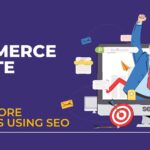Are you aware that 39% of all traffic to online stores comes from search engines? A robust eCommerce website is a must, according to it.
Your website will rank high in the search engine results pages with search engine optimization.
Some people need to understand the significance of SEO for e-commerce websites, although it is a profitable strategy to implement on websites and search engines. A strong SEO strategy will help you drive traffic to your website, regardless of your industry.
Search engine optimization uses user search terms to determine the best, most well-liked, and most useful websites. It’s no secret that SEO is essential if you want people to find your website on search engines because it affects rankings.
Ranking an eCommerce website can be challenging because you have to pay attention to user-friendliness, keyword optimization, and other factors.
Even your interest in the inner workings of eCommerce aids in website optimization for effective SEO.
The following are five justifications for why every e-commerce website needs SEO:
- Increases organic traffic,
- Improves the reputation of your website
- Sets you apart from your rivals,
- Successfully displays your products,
- More time and money are saved.
Let’s examine some recent developments in e-commerce SEO to understand why it is more important in the modern marketing environment:
How can SEO benefit an online store?
One of the best strategies for boosting sales and profits is SEO. It’s simple to believe that SEO has little to no effect on your bottom line because there is so much debate and confusion over terminology and technical concepts surrounding SEO and its application. The reality, however, is quite different.
The lifeblood of e-commerce businesses is a consistent stream of new customers and a core of devoted repeat customers. Your store’s growth is more complex without new buyers to drive new revenue.
SEO helps attract new customers who are more likely to purchase from you. Gaining online customers’ trust and confidence through SEO increases their lifetime value to your company.
These benefits have the following effects on your store:
Greater lead generation:
The most effective method for driving traffic to your website is SEO. Outbrain claims that search is over 300% more effective than social media at driving traffic to content websites.
Likewise, 39% of all traffic to e-commerce websites originates from search engine results. SEO puts your company ahead of those actively looking for it, increasing sales opportunities.
Boost lead quality:
Increasing website traffic and lead qualification are both benefits of e-commerce SEO. Too frequently, people who need more time to be ready to buy or more confidence that your store has the quality or reliability to meet their needs click on e-commerce sites.
Unfortunately, visiting your product pages will only provide them with that knowledge and assist in guiding them through your sales funnel. Instead, by using SEO, you can pinpoint exactly what those people want and give them the facts they need to decide.
Expand sales:
The more clicks you receive from customers interested in your products, the higher your chances of boosting revenue. The 14.6% close rate of search engine leads, according to Backlinko, shows how effectively SEO draws better deals.
That is surely impressive, given that the conversion rate for e-commerce sites ranges from 2 to 4 percent.
Increase authority:
Domain authority in search terms refers to how reliable and respectable a website is in the eyes of search engines. Search engine users trust authoritative websites because they appear higher in search results. Your web content has more control when it is more pertinent and user-friendly.
The essential tool for establishing authority is SEO. Through relevant content and reliable information, SEO aids in the development of a website that people want to visit and trust.
Benefits of SEO for Ecommerce
1. Driving brand awareness. Most e-commerce websites require program optimization to build their brands at a low cost. An appearance on the primary page of search results or in Google’s “Answer Box” could lead a customer to discover your brand for the first time or remind her of a previous visit to your website.
Additionally, some searchers consider ranking well as a recommendation, which increases their propensity to click on a top result.
2. Filling the marketing funnel. The traditional marketing funnel’s awareness, interest, desire, and action stages depend upon an ongoing influx of new customers. SEO is important for generating lower-cost top-of-funnel traffic at the awareness stage.
However, SEO is additionally important during the other phases. The intention revealed in consumers’ keyword selections shifts from informational to transactional as they proceed from awareness to interest (research) to action (purchase). By specializing in the right intent at the correct times on your website, you can influence a shopper’s progression to the next stage and increase the likelihood of conversion.
3. Improving the content. Advertising for keywords with a robust transaction intent makes sense. However, other content, like blog posts, buyer guides, and how-to articles, doesn’t immediately have value.
Efforts to optimize content may result in significant traffic growth at a low cost. Simply knowing what people look for (based on keyword research), optimizing content, having access to your content management system, and having time are all needed. SEO is useful for those kinds of content.
4. Increasing the dimensions of the remarketing audience. Your website’s remarketing audience will grow as more people visit it. Your paid search team can set cookies for remarketing campaigns when customers arrive from organic search. Once they leave your site, you’ll display ads to those customers.
When you consider visits to the top of the funnel, SEO remarketing makes even more sense. As shoppers think about shopping online, they’re passively reminded that your brand gave them something valuable.
5. Capturing the long tail. a part of the long tail consists of questions that account for nearly 40% of all searches, including obscure phrases. Compared to other keywords, long-tail terms have a better conversion rate.
Because they’re constructed hierarchically on a hierarchy of increasing levels of detail, ecommerce sites are typically well-structured to focus on those long-tail searches. Within the case of a clothing website, a typical click path could be Clothing > Men’s Clothing > Accessories > Ties > Blue Ties > Blue Silk Ties. These pages are further along the press path and have a good match with long-tail keywords (such as “men’s blue silk ties”). However, there are too many of them to focus on each one separately. Scalable SEO is the key.
6. Improving the user experience. A positive user experience increases conversions. SEO makes your website easier to know, which improves its usability. This, in turn, can improve rankings.
Keyword data reveals the desires of consumers. They’re looking because they are searching for something. Websites that quickly satisfy those requirements have a higher chance of closing the deal. The identical information aids in understanding how consumers express or think about their desires. The experience is often enhanced by using their keywords on your website. As an example, If the bulk of searchers are looking for “cheap blue silk ties,” highlighting inexpensive options may enhance usability.
Additionally, offering a top-notch user experience is a crucial ranking factor, particularly for Google. Google assumes your site is unsuitable or irrelevant for that question if many users click on it before quickly leaving and returning to the search results. Additionally, that conduct may harm your rankings.
7. Reducing the value of paid search. To calculate the value per click, Google’s Quality Score evaluates the relevance of ads to landing pages. If you collaborate on phrases that are valuable for both organic and paid searches, the content you optimize for SEO should also help Google Ads campaigns.
Better quality scores, cheaper clickthrough rates, and improved performance in organic search all result from optimized landing pages.
8. Creating lasting value. An investment in SEO can pay off in the long run. Its value doesn’t end with the campaign, in contrast to advertising.
Each ongoing optimization project focuses on a special aspect of your site’s technology, design, or content. Each project is going to be valuable in the long run and improve organic search performance for several months or years. However, SEO requires ongoing work.
After learning all this information about e-commerce SEO and its importance, you’ll feel overwhelmed. Building an efficient search engine optimization strategy is difficult, especially when you are part of a saturated market like e-commerce.
That’s why we’re here to assist. With our SEO services, your e-commerce website can achieve success in a saturated market.




